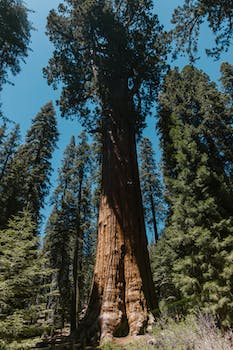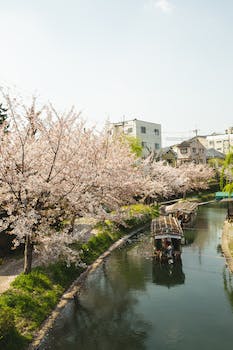

-
Table of Contents
The Mighty Sequoia: America's Towering Giant
Introduction
The Mighty Sequoia: America's Towering Giant is an introduction to the majestic and awe-inspiring Sequoia trees found in the United States. These towering giants are renowned for their immense size, longevity, and ecological significance. This article explores the unique characteristics, historical significance, and conservation efforts surrounding the mighty Sequoia trees, providing readers with a glimpse into the world of these remarkable natural wonders.
The History and Significance of The Mighty Sequoia
The Mighty Sequoia: America's Towering Giant
The history and significance of the mighty sequoia are deeply rooted in the rich tapestry of America's natural heritage. These towering giants, also known as giant sequoias or Sequoiadendron giganteum, are native to the western slopes of the Sierra Nevada mountain range in California. They have captivated the imagination of people for centuries, and their majestic presence continues to inspire awe and wonder.
The story of the mighty sequoia begins long before the arrival of European settlers. Native American tribes, such as the Miwok and the Yokuts, revered these trees and considered them sacred. They believed that the spirits of their ancestors resided within the giant sequoias, and they held ceremonies and rituals to honor and connect with these ancient beings.
It wasn't until the mid-19th century that the mighty sequoia caught the attention of the wider world. In 1852, a hunter named Augustus T. Dowd stumbled upon the grove of giant sequoias that would later be named after him. News of these colossal trees spread rapidly, and soon, adventurers and explorers flocked to witness the awe-inspiring sight for themselves.
One of the most famous early explorers of the sequoia groves was naturalist John Muir. His writings and advocacy played a crucial role in raising awareness about the importance of preserving these ancient giants. Muir's efforts, along with those of other conservationists, led to the establishment of Sequoia National Park in 1890, the second national park in the United States.
The significance of the mighty sequoia extends beyond their sheer size and age. These trees are living witnesses to the passage of time, with some individuals estimated to be over 3,000 years old. They have survived countless wildfires, droughts, and other natural disturbances, adapting and thriving in the face of adversity.
Furthermore, the giant sequoias play a vital role in the ecosystem. Their thick bark and high branches provide shelter for a diverse array of wildlife, including birds, squirrels, and insects. The fallen logs of dead sequoias create a nutrient-rich environment for new seedlings to take root and grow. The trees also contribute to the overall health of the forest by capturing and storing large amounts of carbon dioxide, helping to mitigate the effects of climate change.
Despite their resilience, the mighty sequoias face numerous challenges in the modern world. Climate change, with its rising temperatures and prolonged droughts, poses a significant threat to their survival. In recent years, scientists have observed signs of stress and decline in some sequoia groves, highlighting the urgent need for conservation efforts.
To protect these national treasures, various measures have been implemented. Controlled burns are conducted to mimic the natural fire regime that sequoias depend on for their regeneration. Efforts are also underway to reduce the impact of air pollution and invasive species on the groves. Additionally, public education and outreach programs aim to raise awareness about the importance of preserving these ancient giants for future generations.
In conclusion, the mighty sequoia holds a special place in America's natural heritage. Their history and significance are intertwined with the stories of Native American tribes, early explorers, and conservationists. These towering giants not only inspire awe and wonder but also play a crucial role in maintaining the health and balance of the ecosystem. As we navigate the challenges of the modern world, it is our responsibility to ensure the preservation and protection of these magnificent trees for generations to come.
Exploring the Unique Characteristics of The Mighty Sequoia

The Mighty Sequoia: America's Towering Giant
Exploring the Unique Characteristics of The Mighty Sequoia
The mighty sequoia, also known as the giant sequoia or Sequoiadendron giganteum, is one of the most awe-inspiring trees in the world. Native to the western slopes of the Sierra Nevada mountains in California, these towering giants have captured the imagination of people for centuries. In this article, we will explore the unique characteristics that make the mighty sequoia truly remarkable.
First and foremost, the size of the mighty sequoia is truly astounding. These trees can reach heights of over 300 feet, making them some of the tallest trees on the planet. In fact, the tallest known sequoia, named Hyperion, stands at a staggering 379.7 feet tall. To put that into perspective, that's taller than the Statue of Liberty! Not only are they tall, but they also have massive trunks that can measure up to 40 feet in diameter. These enormous dimensions make the mighty sequoia a true giant among trees.
Another unique characteristic of the mighty sequoia is its incredible lifespan. These trees can live for thousands of years, with some specimens estimated to be over 3,000 years old. This longevity is due in part to their thick bark, which can be up to three feet thick. This bark acts as a natural fire shield, protecting the tree from wildfires that are common in their native habitat. Additionally, the mighty sequoia has a remarkable ability to regenerate itself. When a sequoia is damaged or cut down, it can sprout new growth from its base, ensuring its survival for generations to come.
The mighty sequoia is also known for its unique reproductive strategy. Unlike most trees, which rely on wind or animals to disperse their seeds, the sequoia has cones that are specifically adapted to release their seeds in response to fire. When a fire sweeps through a sequoia grove, it opens the cones and releases thousands of seeds onto the newly cleared forest floor. The heat from the fire also helps to create the ideal conditions for the seeds to germinate and grow. This adaptation ensures that the mighty sequoia can thrive in its fire-prone environment.
In addition to their impressive size and longevity, the mighty sequoia also plays a vital role in the ecosystem. These trees provide habitat for a wide variety of species, including birds, mammals, and insects. The thick bark of the sequoia also provides a unique microhabitat for many organisms, including lichens and mosses. Furthermore, the mighty sequoia is an important carbon sink, absorbing and storing large amounts of carbon dioxide, which helps to mitigate climate change.
In conclusion, the mighty sequoia is a truly remarkable tree with unique characteristics that set it apart from all others. Its towering height, incredible lifespan, and ability to regenerate make it a true giant among trees. Its reproductive strategy, specifically adapted to fire, ensures its survival in its fire-prone habitat. Additionally, the mighty sequoia plays a vital role in the ecosystem, providing habitat for numerous species and acting as a carbon sink. As we continue to explore and appreciate the wonders of the natural world, let us not forget the mighty sequoia, America's towering giant.
Conservation Efforts to Protect The Mighty Sequoia
The mighty sequoia, also known as the giant sequoia or Sequoiadendron giganteum, is one of the most iconic trees in America. These towering giants can reach heights of up to 300 feet and have a lifespan of over 3,000 years. However, despite their impressive stature and longevity, the mighty sequoias are facing numerous threats that put their survival at risk. In response to these challenges, conservation efforts have been implemented to protect these majestic trees and ensure their preservation for future generations.
One of the primary threats to the mighty sequoia is habitat loss. Historically, these trees covered a vast area of the western United States, but due to logging and urban development, their range has significantly diminished. Today, the majority of sequoia groves are confined to protected areas such as national parks and reserves. These protected areas serve as havens for the mighty sequoias, providing them with the necessary space and resources to thrive.
In addition to habitat loss, climate change poses a significant threat to the mighty sequoia. Rising temperatures and changing precipitation patterns can have detrimental effects on these trees. Sequoias rely on a specific set of environmental conditions to grow and reproduce, and any alterations to these conditions can disrupt their life cycle. To mitigate the impacts of climate change, conservationists are working to reduce greenhouse gas emissions and promote sustainable practices that help preserve the natural habitats of the mighty sequoias.
Another crucial aspect of conservation efforts is the prevention of wildfires. While fire is a natural part of the sequoia ecosystem and can even benefit the trees by clearing out competing vegetation, the increasing frequency and intensity of wildfires in recent years have become a cause for concern. Uncontrolled fires can destroy entire groves and kill off young sequoias that have not yet developed their fire-resistant bark. To protect the mighty sequoias from devastating wildfires, prescribed burns and other fire management techniques are employed to reduce fuel loads and create firebreaks.
Furthermore, invasive species pose a significant threat to the mighty sequoia. Non-native plants and insects can outcompete native species for resources and disrupt the delicate balance of the ecosystem. For instance, the sequoia bark beetle, a non-native insect, has been responsible for the decline of many sequoias by infesting and killing them. To combat invasive species, conservationists conduct regular monitoring and implement measures to control their spread. These efforts include the removal of invasive plants and the introduction of natural predators to keep populations in check.
Conservation efforts to protect the mighty sequoia also involve public education and outreach. Raising awareness about the importance of these trees and their fragile ecosystem is crucial in garnering support for conservation initiatives. Educational programs, guided tours, and interpretive signage in national parks help visitors understand the significance of the mighty sequoias and the need to protect them. Additionally, partnerships with local communities and organizations play a vital role in fostering a sense of stewardship and collective responsibility for the preservation of these natural wonders.
In conclusion, the mighty sequoia is an awe-inspiring symbol of America's natural heritage. However, the survival of these towering giants is threatened by habitat loss, climate change, wildfires, and invasive species. Conservation efforts to protect the mighty sequoia encompass a range of strategies, including habitat preservation, climate change mitigation, fire management, invasive species control, and public education. By implementing these measures, we can ensure the continued existence of these majestic trees and preserve their beauty and ecological importance for generations to come.
Q&A
1. What is the height of a fully grown Mighty Sequoia?
The height of a fully grown Mighty Sequoia can reach up to 280 feet (85 meters).
2. Where can you find the Mighty Sequoia in the United States?
The Mighty Sequoia is primarily found in the Sierra Nevada mountain range in California, United States.
3. How long can a Mighty Sequoia live?
Mighty Sequoias have an average lifespan of around 2,000 to 3,000 years.
Conclusion
In conclusion, the Mighty Sequoia is a towering giant that holds great significance in America. Its impressive size, longevity, and ecological importance make it a symbol of strength and resilience. The preservation and conservation of these majestic trees are crucial to maintaining the balance of our ecosystems and preserving the natural beauty of our country.












